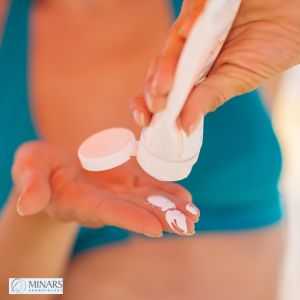Sun exposure is the single most important factor in developing skin cancer. As dermatologists practicing in South Florida, we see firsthand how cumulative sun damage increases the risk of basal cell carcinoma, squamous cell carcinoma, and melanoma. Protecting your skin every day is the best way to reduce this risk and maintain healthy skin in the long term.
Why Sun Protection Matters
UV rays from the sun cause DNA damage to skin cells, which can trigger mutations that lead to cancer. Even incidental exposure, such as driving with sunlight through your car window or spending short periods outside, adds up. The good news is that consistent sun protection significantly reduces your risk of developing skin cancer and helps prevent premature aging.
Choosing the Right Sunscreen
We recommend using a broad-spectrum sunscreen with an SPF of at least 30 daily. Broad-spectrum protection means it shields against both UVA and UVB rays, which contribute to skin damage and increased cancer risk. Many patients believe that higher SPFs, such as 50 or 100, offer perfect protection, but the difference between SPF 30 and SPF 50 is minimal—SPF 30 blocks approximately 97.5 percent of UVB rays.
Mineral-based sunscreens containing zinc oxide or titanium dioxide offer a physical barrier by sitting on top of the skin and reflecting UV rays. These are excellent options, especially for individuals with sensitive skin or concerns about the ingredients in chemical sunscreens.
Reapplication Is Key
Sunscreen is not a one-and-done product. If you are outdoors, reapply every two hours or immediately after swimming or sweating. Many people underestimate how quickly sunscreen wears off, which leaves skin unprotected during peak sun exposure.
Additional Protective Measures
Sunscreen is only one part of a sun-safe routine. Wearing sun-protective clothing, including long sleeves and wide-brimmed hats, shields skin from direct rays. UV-protective sunglasses also help safeguard your eyes, which are vulnerable to UV damage and melanoma.
Seek shade during peak sunlight hours, usually between 10 a.m. and 4 p.m., when UV radiation is strongest. This simple habit drastically reduces your cumulative sun exposure.
Understanding Visible Light and Hyperpigmentation
Beyond UV rays, visible light, such as blue light emitted from screens and indoor lighting, can also contribute to skin aging and pigmentation changes. Tinted sunscreens containing iron oxide offer enhanced protection against visible light, making them a great choice for daily use, particularly for individuals prone to hyperpigmentation.
Sun Protection And Sun Safety Tips for All Ages
Just like we protect babies and children from sun exposure with hats and sunscreen, adults should adopt similar habits. Skin cancer risk is cumulative, so starting young with consistent sun protection sets you up for healthier skin in the future. Sun protection is the most effective way to prevent many types of skin cancer. Developing a daily routine that includes sunscreen, protective clothing, and sun-safe behaviors is an investment in your long-term health. If you have questions about the best products or strategies for your skin type, don’t hesitate to contact Minars Dermatology for a personalized consultation.










